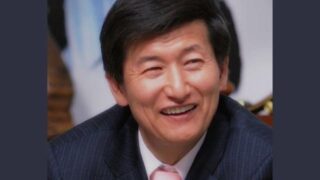The movement managed to continue and grow notwithstanding the detention of its founder. One of the reasons was his unconventional theology.
by Massimo Introvigne
Article 3 of 5. Read article 1 and article 2.


In the first articles of this series we examined the origins and history of Providence, a South Korean Christian new religious movement that continued to prosper and grow notwithstanding the fact that, between 2008 and 2018, its founder President Jung Myung Seok served a ten-year jail term for alleged sexual abuse. This article and the next explore the theology that sustained this growth.
As usual with religious movements, members are not interested in comparative studies of their doctrine or discussions about its origins. For their internal point of view, all comes from divine revelation, and President Jung reports daily conversations with the Holy Trinity that accompanied most of his adult life. For outsiders, however, questions about sources are not irrelevant.
Critics maintain that President Jung’s core teachings (the so-called “Thirty Lessons”) are remarkably similar to the Divine Principle of the Unification Church. The relationship has been constructed as alleged plagiarism, or at least, as French scholar Nathalie Luca maintained, as “a sort of updating of the Unification Church.” Local Korean critics have also accused Jung of “plagiarizing” Korean somewhat unorthodox theologians Na Un Mong and Han Enoch. Jung would say that Moon, Na, and Han had all their own prophetic missions announcing his own, although Moon betrayed his mission under the influence of his wife.
Although there are similarities, I disagree with the general assessment that Jung just “plagiarized” Moon or simply “updated” the Divine Principle. A careful reading of the “Thirty Lessons” shows both similarities and important differences.


The “Thirty Lessons” are based on the idea that Christianity should conform to reason and science and, when miracles and other events in the Bible appear to violate the laws of nature, they should be interpreted symbolically. Biblical interpretation in Providence is based on four principles: analogy (“the Bible interprets itself”); historical context; double interpretation from the respective points of view of “spirit” and “flesh”; and numerology.
President Jung teaches that human beings consist of three components, body, soul, and spirit (a teaching he claims to derive from 1 Thessalonians 5:23), in the image of the Trinity. The mind is not a component of the human being, but is part of the body. There are different soul levels: the physical soul is related to physical body, while the spiritual soul allows connections with spiritual beings and the spiritual world. Animals have a body and a physical soul, but not a spiritual soul nor a spirit, which according to Jung shows that the theory of evolution is false, since spiritual soul and spirit cannot evolve from body. The universe progresses through a law of nature designed by God.
The soul acts as a mediator between body and spirit. When we see ourselves in dreams, we see our “soul body.” There are other spiritual techniques to access the “soul world” outside our dreams, and it is believed that in the soul world we can discern in a better way our own and other people’s thoughts and, to some extent, predict the future.
At death, the body dies, but the soul, which includes all the memories, survives, just “as a memory drive [which] is taken out of a computer,” and unites with the spirit. While we are alive, according to our good or bad deeds, the spirit dwells either in the domain of life or the domain of death; there is also a middle level domain.


Heaven and Paradise, according to Providence, are not the same. Actually, the world is divided in six main levels (although, from a more complex perspective, these levels can in fact be millions): Hell, Abyss, Hades, and Heaven, Paradise, and the Good Spiritual World. Heaven in turn is divided in the three levels of servants, children, and brides of God (which also correspond to the Old, New, and Complete Testament). The Good Spiritual World and Hades (also called the evil spiritual world) are on earth, all the other levels are destinations for our souls after this life.
In almost all cases, where we will go after death is determined by what we did in life, although in some special circumstances the spirit is able to lift itself up in the spiritual world. Spirits can visit their own and lower levels, but not upper levels. While on earth, we cannot see the spiritual worlds, but we can receive information about them by “becoming spiritual,” understanding the Bible, receiving spiritual dreams, and learning from spirits who come on a mission from Heaven.
God (regarded as male in Providence’s theology) created human beings to be his brides (irrespective of whether they are male or female), and exchange love with him. Archangel Lucifer opposed God’s creation of human beings, as he was envious that they would be closer to God than the angels. God could have thrown him into Hell immediately, but instead exiled him to earth, giving him an opportunity to repent. But he continued to oppose God, and induced Eve to fall.
The fruit of the Tree of Good and Evil is the female sexual organ, and eating it for Eve meant making love with Adam after having been spiritually corrupted by the serpent (Lucifer). Those familiar with the Unification Church would recognize here one of the elements of similarity. The fact that the original sin had a sexual component does not mean that sex is regarded as evil by Providence. What is evil is becoming addicted to sex, or indulging in its practice before having achieved the necessary spiritual maturity.
As a consequence of the Fall, Lucifer became Satan, and Eve, Adam, and their descendants could not become brides of God, only servants. The Trinity could have created human beings as perfect and incapable of sinning. But it did not, because a love for God conquered by overcoming imperfections and temptations is more valuable than a love imposed by God and practiced without effort.
Because of the Fall, humans need to be saved. This was, and is, the work of the Holy Son, which we will discuss in our next article.









